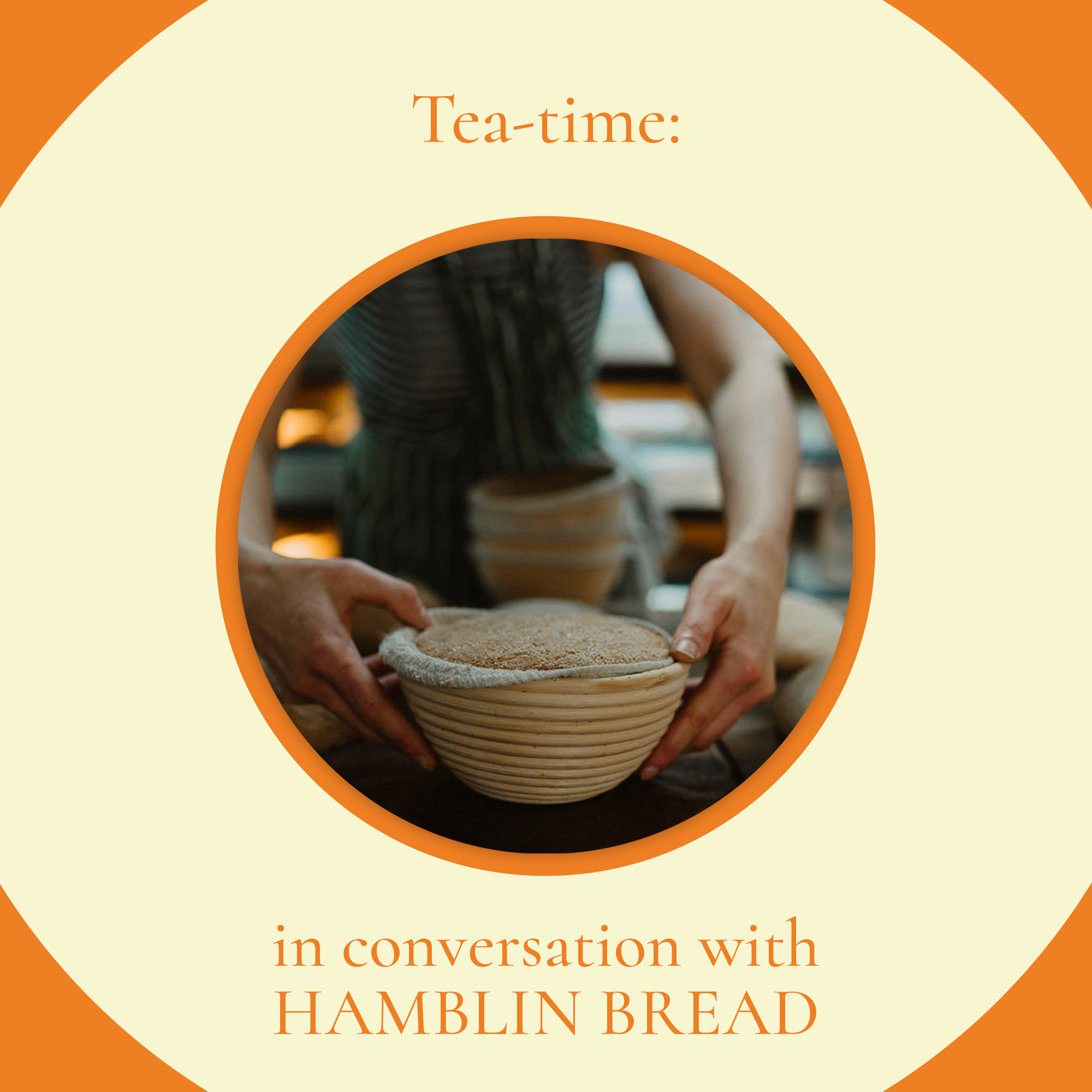
Tea-time: In Conversation with Hamblin Bread
by Shao-Yi Wong | November 2, 2022
To bake, according to Kate Hamblin, is to surrender your hands to the rhythm of your ingredients. Hugo Thurston and Kate Hamblin opened Hamblin Bread on Iffley Road in 2018, placing stone-milled flour and heritage grains at the heart of their neighbourhood bakery. Shao-Yi Wong interviews Thurston and Hamblin about their approach to the protean yet fundamental craft that is bread-making.
Shao-Yi Wong – The flavour profiles of your breads and bakes are always so incredible, and I think seasonal. What is your process for coming up with new items for the menu?
Hugo Thurston – We are absolutely seasonal. We’re totally led by what’s available, we try to source products locally; not necessarily because that makes them better but because that means with a shorter supply chain, you almost certainly know more about the product. There’s also the question of who we have in the team at that point and what their skill set is. And then there’s just a very natural kind of process whereby Kate or somebody else might say, ‘Oh, I was thinking maybe we could make this’ and we’ll talk about that at our weekly pastry meeting.
Kate Hamblin – We’re very overtly not trendy. I think there’s an emphasis in food now on innovation. Whereas for us, we are very much led by our ingredients rather than any kind of fashion. I’m essentially making bread the way it would have been made hundreds of years ago. I’m refining that process, but within the very narrow parameters of my flour, the salt we use, the timings of the bakery and things like that.
HT – You might look at those parameters and think: isn’t that restrictive? But there’s a kind of freedom to be had.
KH – When we make the bread, it’s just three ingredients. Because of the nature of the flour we use, I feel like I could make that bread every day for the rest of my life and never get bored.
SYW – How did you get into the traditional way of making bread and using heritage grains and stone-milled flour?
KH – I worked at a bakery called E5 Bakehouse in East London. In the time I was there, we began to really question where the flour was from. My assumption was that if it was organic, which it always was, it would be from the UK, but digging a bit deeper, I realised that even if it’s milled in the UK, the grain was most likely from Kazakhstan or Canada. The traditional belief has been that British wheat is too weak to make bread from; a pervasive myth that it’s impossible to make bread from UK grain. And then that led us on a whole journey. During the time I was there, we went from using no British grain to sourcing entirely British grain. They bought a mill and we began milling our own flour. We had to change many of our techniques; it was a very different and very challenging process. But the flavour you got with the traditional stone-milled grain was incredible. There was no going back once you started on that journey.
Also, if you’re using British grain, you have a chance to form relationships with the people that are milling and growing your grain. And so with the heritage stuff, one of the things we were most looking forward to about setting up in Oxford was being really near the heritage wheat farmer, John Letts. We hoped to be able to work very closely with him and we have done so since the beginning.
SYW – When you started using stone-milled flour, did you buy your own mill?
KH – More bakeries are getting their own mills, but we don’t have the space. And very early on, John introduced us to David Howell at Offley Mill. His family has been milling for generations. How it works is they have a mill pond which feeds the waterwheel; that wheel then turns these massive French stones which grind the flour. Their family has records of picking those stones up from the Liverpool docks in the 1720s or something like that. It’s just this amazingly rich history.
HT – The mill pond at Offley is mentioned in the Domesday Book.
KH – So yes, it’s really, really old. And it’s a heritage craft and unfortunately it’s dying. It’s basically the next best thing to having my own mill or and in some ways, it’s much better because David mills fresh for us. He has a lifetime’s worth of skill.
SYW – I feel that there’s just something so fundamental about the way you approach bread.
KH – Yeah, what’s good now is the big movement amongst bakers towards using UK stone-ground flour and buying mills and things like that. But I would definitely say our relationship with David is what I really like to emphasise because there aren’t many millers like him left and it’s a tough game, the margins are tight. Before we started Hamblin, the big French stones had remained still for a long time. And so I think it’s cool that this bakery two hours away from him is responsible for keeping those millstones turning.
SYW – You’re keeping the heritage alive.
KH – Yeah, we always just hope that he’s not going to give it off or retire anytime soon.
HT – I always love telling this story about the thing that’s kept those millstones turning. In the 70s, David’s dad had given up on milling grain and they had diversified the family business slightly. Because the market was just vanishing. People didn’t want stone-milled flour anymore. A friend of David’s dad had a contract milling chapati flour for South Asian immigrant families in the West Midlands and said ‘Look, I am retiring, do you want to take this on, to be able to keep the mill running?’ And David’s dad agreed, but didn’t think that was going to be his main business. But actually, meeting this particular demand for stone-milled, whole meal flour (which is what you traditionally use to make chapatis) turned into their main business. They milled it through the 80s and 90s, until David was introduced to John Letts. And to this day, even though the amount of chapati flour they make has fluctuated somewhat, the words ‘chapati flour’ are painted on the side of David’s van. I’ve always thought of that as a remarkable story about immigration – that demand for quality flour kept the mill going. Otherwise, who knows where we’d be now?
At this juncture, Kate reminds us that she must soon return to her bread. The conversation turns from flour to her views on the art – or rather, craft – of making bread.
SYW – Apart from flour, I’m also interested in your personal take on bread. What bread do you most enjoy making for yourself?
HT – I’m going to say one thing on this, if Kate had her way, she would only make type of bread. That’s true, isn’t it?
KH – Pretty much yeah. I’m a purist. I basically see my job as a kind of husbandry – helping that flour reach its full potential via the process of fermentation. I like extremely simple bread, Hamblin’s country loaf. A bit of wholemeal flour, a bit of sifting, and then it’s all about bringing the flavour out of the grain through the fermentation. That’s why our crust is maybe darker than other breads; that’s a kind of badge of honour because you can only get that if your fermentation is really on point. For me, just making a country loaf every day is enough to keep my job interesting because it changes dramatically from the summer to the winter. And every time we get a new batch of grain through somebody, we go through a process of adaption and working out exactly what each particular grain wants.
SYW – What advice do you have for home bakers or novice bakers looking to use heritage grains in their bread?
KH – I would absolutely say give it a go. And if you’re making sourdough, you might need to add a bit more water, you might need to change the way you shape. You can always stick it in a tin if all else fails and bake it though. The other thing to say is that the trend in sourdough over the last decade has been Tartine style, with massive holes in the crumb. That is a result of very strong roller-milled flour and very hydrated dough. You have to accept that you’re not going to get that with UK grain but that’s not a sign of failure. It’s just a sign of working with totally different flour. So give it a go. Don’t be disappointed because even though you won’t get the big holes but the flavour, the flavour will be much better.
SYW – The sense I’m getting is that bread to you is about artistry, holding yourself to lovely high standards. What do you look for in a baker who wants to work at Hamblin?
KH – I see it as less of an art and more as a craft. And by craft, I mean something repetitive that you’ve honed over the course of many years, rather than something that you have creative whims about all the time. A baker has quite a specific personality – they like solitude, they’re relatively antisocial. They like repetition. The thing I always say is ‘it’s not about you, it’s about the bread.’ If someone comes to work here, they have to take the ego out. You’re basically working to something else’s schedule; you’re doing whatever the dough is telling you to do.
After Kate leaves to go back to the bread, Hugo and I discuss his experiences in the F&B industry leading to Hamblin. Hugo is keen to emphasise that the bakery is “Kate’s baby”. He modestly assigns himself “a supporting role”.
HT – I was always front of house. I started working as a waiter at Chiang Mai Kitchen in Oxford, worked in lots of restaurants in Oxford, and then worked in London restaurants. And when Kate and I met, she was a chef and I was a manager. For a long time, working in food was just something I did to kind of pay the bills because my ambition at the time lay in other areas. But gradually, almost without my noticing, food and drink and restaurants have become something that is incredibly important to me. And then it became a career. One that’s been very enjoyable.
SYW – So did you grow up in Oxford?
HT – Yeah. Kate studied at Oxford. All my family were here. We were in London, decided that we wanted to work together and start a bakery. We wanted to be able to live in the area in which the business was, we wanted it to be in an area that we knew, which kind of narrowed down the options once we ruled out London. There were lots of other reasons, personal reasons to come back to Oxford. It’s literally a homecoming for me. I went to school here; I grew up here. So yeah, absolutely. Full circle.
SYW – What is your favourite food or bread memory at Hamblin?
HT – It has to be tasting the first loaves that came out. They were a long way from being perfect. For all sorts of reasons, they weren’t the way the bread is now. Nonetheless, I remember trying the first loaf and thinking: Okay, we’re onto something here. I mean, I knew it’d be good, I’d tasted Kate’s baking. We were also not going into this cold because we had a decade’s worth of experience between us. But just tasting that first bread made me wildly excited. I was driving over town and dropping it off to people so they could taste it.
SYW – One last question: what would you tell anyone thinking of coming to Hamblin for the first time?
HT – I would just say: please come. Come in and talk to us, we’ll always have time (unless it’s a Saturday). We think that it’s so important to make people feel welcome. If you’re just curious, that’s great. We’re happy to let people try stuff. ∎
Interview by Shao-Yi Wong.




